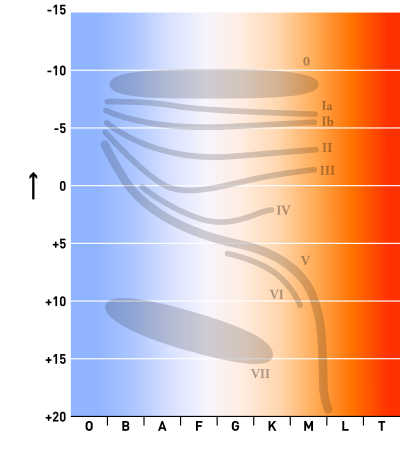K-type main-sequence star
A k-type main-sequence star (K V), also referred to as an orange dwarf or K dwarf, is a main-sequence (hydrogen-burning) star of spectral type K and luminosity class V. These stars are intermediate in size between red M-type main-sequence stars and yellow G-type main-sequence stars. They have masses between 0.45 and 0.8 times the mass of the Sun[1] and surface temperatures between 3,900 and 5,200 K.[2], Tables VII, VIII. Better-known examples include Alpha Centauri B (K1 V) and Epsilon Indi.[3] These stars are of particular interest in the search for extraterrestrial life[4] because they are stable on the main sequence for a very long time (15 to 30 billion years, compared to 10 billion for the Sun). This may create an opportunity for life to evolve on terrestrial planets orbiting such stars. K-type stars also emit less ultraviolet radiation (which can damage DNA and thus hamper the emergence of life) than G-type stars like the Sun.[5] K-type main-sequence stars are about three to four times as abundant as G-type main-sequence stars, making planet searches easier.[6]
Spectral standard stars
The revised Yerkes Atlas system (Johnson & Morgan 1953)[7] listed 12 K-type dwarf spectral standard stars, however not all of these have survived to this day as standards. The "anchor points" of the MK classification system among the K-type main-sequence dwarf stars, i.e. those standard stars that have remain unchanged over the years, are Epsilon Eridani (K2 V), and 61 Cygni A (K5 V).[8] Other primary MK standard stars include 70 Ophiuchi A (K0 V), 107 Piscium (K1 V), HD 219134 (K3 V), TW Piscis Austrini (K4 V), HD 120467 (K6 V), 61 Cygni B (K7 V) .[9] Based on the example set in some references (e.g. Johnson & Morgan 1953,[10] Keenan & McNeil 1989[9]), many authors consider the step between K7 V and M0 V to be a single subdivision, and one rarely encounters K8 or K9 classifications in the literature. Recent, however, HIP 111288 (K8V) and HIP 3261 (K9V) have been proposed as spectral standard stars.[11]
Planets
Some of the nearest K-type stars known to have planets include Alpha Centauri B, Epsilon Eridani, HD 192310, Gliese 86, and 54 Piscium.
See also
- Solar analog
- Red dwarf
- Stellar classification, Class K
- Star count, survey of stars
- Habitability of K-type main-sequence star systems
References
- ^ A Modern Mean Stellar Color and Effective Temperatures (Teff) # Sequence for O9V-Y0V Dwarf Stars, E. Mamajek, 2011, website
- ^ Empirical bolometric corrections for the main-sequence, G. M. H. J. Habets and J. R. W. Heintze, Astronomy and Astrophysics Supplement 46 (November 1981), pp. 193–237.
- ^ SIMBAD, entries for Alpha Centauri B and Epsilon Indi, accessed on line June 19, 2007.
- ^ David Shiga (6 May 2009). "Orange stars are just right for life". New Scientist. Retrieved 29 May 2016.
- ^ [1], retrieved on Feb 8, 2015.
- ^ [2], retrieved on May 6, 2009.
- ^ Fundamental stellar photometry for standards of spectral type on the revised system of the Yerkes spectral atlas H.L. Johnson & W.W. Morgan, 1953, Astrophysical Journal, 117, 313
- ^ MK ANCHOR POINTS, Robert F. Garrison
- ^ a b The Perkins Catalog of Revised MK Types for the Cooler Stars, P.C. Keenan & R.C McNeil, "Astrophysical Journal Supplement Series" 71 (October 1989), pp. 245–266.
- ^ Fundamental stellar photometry for standards of spectral type on the revised system of the Yerkes spectral atlas, H.L. Johnson & W.W. Morgan, 1953, Astrophysical Journal, 117, 313
- ^ Intrinsic Colors, Temperatures, and Bolometric Corrections of Pre-main-sequence Stars, M.J. Pecaut & E.E. Mamajek, 2013, "Astrophysical Journal Supplement", 208, 9

